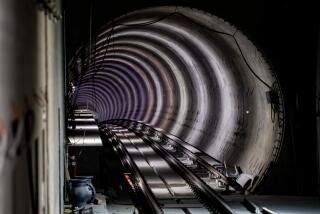Bus-only lanes proposed for Wilshire Boulevard
- Share via
Bus commuters along congested Wilshire Boulevard have long dreamed of barreling along in their own special lane, unimpeded by automobiles and other vehicles.
Come Dec. 9, they could get their wish as the Los Angeles County Metropolitan Transportation Authority board considers a $31.5-million proposal to designate bus-only lanes during morning and evening rush hours along 8.7 miles of the busy boulevard, the region’s most heavily used transit corridor.
The Bus Riders Union and other proponents tout the Wilshire “bus rapid transit” project as a boon to public health and the environment that would improve the reliability of service, shorten transit times and encourage more drivers to get out of their cars and take the bus.
But high-rise residents of Westwood’s “condo canyon” are pushing to exempt a nearly mile-long stretch of Wilshire between Comstock and Selby avenues because, they contend, the bus-only lane would cause huge backups for motorists in an area where traffic already moves smoothly. The condo dwellers say a bus-only lane would also interfere with residents or delivery people seeking to leave or enter buildings’ driveways or parking garages.
Project proponents say they fear that exempting that stretch of high-rise buildings on Wilshire could torpedo $23 million in Federal Transit Administration funding under a program to encourage bus rapid transit projects nationwide. The balance of the project funding would come from Measure R, a voter-approved half-cent sales tax in Los Angeles County designated for transit programs.
“The exemption doesn’t merit risking the entire project,” said Sunyoung Yang, lead organizer of the Bus Riders Union. “This project is going to bring better bus reliability and … a 15-to-20-minute reduction in time for people traveling on the Wilshire corridor.”
Los Angeles County Supervisor Zev Yaroslavsky, a Metro board member, said he thought the residents had a point, supported by a traffic engineering study by Raju Associates, a consulting firm.
“The whole idea is to try to move bus traffic along but not to gratuitously do that at the expense of vehicular traffic,” Yaroslavsky said. “Making a bus-only lane on this particular stretch is of no value to buses, and it considerably degrades everybody else.”
Yaroslavsky said Metro planned to ask the Federal Transit Administration soon whether the Westwood exemption would imperil the federal funding.
Bus rapid transit lanes exist in Seoul; Sao Paulo, Brazil; Sydney, Australia; and other cities. In the United States, some cities are planning and implementing variations on the theme. Los Angeles is in the forefront of the new federal program, said Brad McAllester, Metro’s executive officer for long-range planning and coordination.
“This was the first round of applications, and we ranked No. 1,” he said.
With more than 80,000 bus boardings each weekday, Wilshire is the most heavily used transit corridor in Los Angeles County, according to Metro. The boulevard also has some of the highest traffic volume, with about 110,000 automobiles passing through its intersections with Westwood Boulevard and Gayley and Veteran avenues each weekday. Average daily traffic figures are lower along the eastern portion of the project area, producing an average volume for the corridor of an estimated 80,000 vehicles.
A Metro staff report said data collected by Metro and the Los Angeles Department of Transportation indicated that buses on the Comstock-to-Selby portion of Wilshire do experience delays because of traffic congestion at Beverly Glen Boulevard and farther west. “Including this segment for one contiguous bus lane project with accumulative benefits and time savings is critical to achieving [the project’s] goals,” the report said.
The Wilshire bus rapid transit project would install bus lanes in the lane closest to the curb on either side of Wilshire Boulevard between South Park View Street — which borders MacArthur Park — and Centinela Avenue, with a gap where Wilshire passes through Beverly Hills. Metro said it had not had time to coordinate with Beverly Hills officials.
If approved, the project could be completed by summer 2012.
Among those promoting the project is Juan Matute, director of a UCLA program that encourages Southern California governments to reduce greenhouse gas emissions. Matute puts his commute where his mouth is, riding the bus along Wilshire between UCLA and his Santa Monica residence. Some days, he said, he sits on the bus for 60 minutes, but the average is between 35 and 40.
“I’m looking at it as someone interested in moving the city toward a more sustainable form of transportation,” he said, “and somebody who will get home 10 to 15 or even 30 minutes quicker.”
More to Read
Sign up for Essential California
The most important California stories and recommendations in your inbox every morning.
You may occasionally receive promotional content from the Los Angeles Times.













